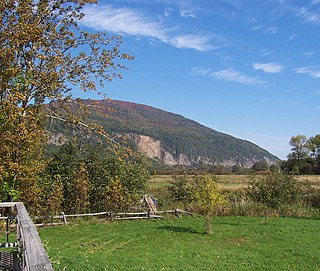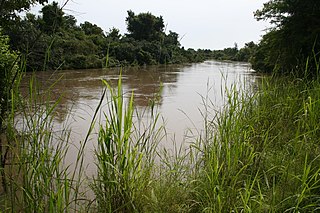
The Cap Tourmente National Wildlife Area is a National Wildlife Area (NWA) located on the north shore of the Saint Lawrence River in the National Provincial Capital Region of Quebec, established on 28 April 1978. It is one of the critical habitats for the greater snow goose during migration. Flocks of tens of thousands of these birds stop over to feed on the bullrushes in the spring and fall. The tidal marsh was recognized as a wetland of international significance per the Ramsar Convention in 1981, the first North American site to receive that distinction.

Songkhla Lake is the largest natural lake in Thailand. It is on the Malay peninsula in the southern part of the country. Covering an area of 1,040 km2 it borders the provinces of Songkhla and Phatthalung. Despite being called a lake, this water feature is actually a lagoon complex geologically.

Wigry National Park is a national park in Podlaskie Voivodeship in north-eastern Poland. It covers parts of the Masurian Lake District and Augustów Primeval Forest. It is named after lake Wigry, the largest of the park's many lakes. It is also classed as a Ramsar wetland site, one of 13 such sites in Poland.

The Madagascar dry deciduous forests represent a tropical dry forest ecoregion situated in the western and northern part of Madagascar. The area has high numbers of endemic plant and animal species but has suffered large-scale clearance for agriculture. They are among the world's richest and most distinctive dry forests and included in the Global 200 ecoregions by the World Wide Fund. The area is also home to distinctive limestone karst formations known as tsingy, including the World Heritage Site of Bemaraha.

The wildlife of Cameroon is composed of its flora and fauna. Bordering Nigeria, it is considered one of the wettest parts of Africa and records Africa's second highest concentration of biodiversity. To preserve its wildlife, Cameroon has more than 20 protected reserves comprising national parks, zoos, forest reserves and sanctuaries. The protected areas were first created in the northern region under the colonial administration in 1932; the first two reserves established were Mozogo Gokoro Reserve and the Bénoué Reserve, which was followed by the Waza Reserve on 24 March 1934. The coverage of reserves was initially about 4 percent of the country's area, rising to 12 percent; the administration proposes to cover 30 percent of the land area.

Benin has varied resources of wildlife comprising flora and fauna, which are primarily protected in its two contiguous protected areas of the Pendjari National Park and W National Park. The former is known for many species of avifauna and the latter park is rich in mammals and predators. In addition, many other forest reserves are noted in the country but are not easily accessible, well protected or adequately surveyed for its wildlife resources. The protected area system of Benin defined as National Protected Area System is situated in the northern Benin, mostly with a woody savanna ecosystem. It covers 10.3% of the national territory and is part of the three nation transboundary W-Arly-Pendjari (WAP) complex.

The Sakalava rail is a species of bird in the family Rallidae. It is endemic to western Madagascar. This bird is small with brown upperpart feathers, grey underparts, a yellow bill and red legs.

Menabe Antimena is a protected area in Menabe region of western Madagascar.

The wildlife of Niger is composed of its flora and fauna. The wildlife protected areas in the country total about 8.5 million hectares, which is 6.6% of the land area of the country, a figure which is expected to eventually reach the 11% percent target fixed by the IUCN with addition of more areas under the reserve category. The dama gazelle has become a national symbol. Under the Hausa name meyna or ménas the dama appears on the badge of the Niger national football team, who are popularly called the Ménas.
Kasijy Special Reserve is a 19,800 hectares wildlife reserve in the Betsiboka region of Madagascar. Nearly half of the species of plants and animals recorded within the reserve are endemic to Madagascar and BirdLife International have listed the reserve as an Important Bird Area.)

Protected areas of Poland include the following categories, as defined by the Act on Protection of Nature of 16 April 2004, by the Polish Parliament:

The wildlife of South Sudan refers to the natural flora and fauna of South Sudan. South Sudan includes the Sudd, one of the world's largest wetlands. According to the American biologist and conservationist, J. Michael Fay, South Sudan "could present the biggest migration of large mammals on earth", while Wildlife Conservation Society (WCS) reports southeast Sudan has a migration of 1.3 million antelopes. The region has a low density human population, with approximately 7 million people spread over approximately 619,745 km2 (239,285 sq mi).

The wildlife of Mongolia consists of unique flora and fauna in 3092.75 habitats dictated by the diverse and harsh climatic conditions found in the country. Then the north, salty marshes, fresh-water sources, desert steppes at the centre, and semi deserts, as well as the hot Gobi desert in the south, the fifth largest desert in the world.

The wildlife of Ukraine consists of its diverse fauna, flora and funga. The reported fauna consists of 45,000 species when including the areas of the Black Sea and the Sea of Azov. Ukraine's protected environments consist of 33 Ramsar sites covering an area of 7,446.51 square kilometres (2,875.11 sq mi). Biosphere nature reserves and three national parks are all part of the GEF projects portfolio of conservation of biodiversity in the Danube Delta. Their vegetation pattern is mixed forest area, forest-steppe area, steppe area, Ukrainian Carpathian Mountains and Crimean Mountains. Some of the protected areas that were reserves or parks are subsumed under the biosphere reserves.
The Hanma Biosphere Reserve is located in Inner Mongolia and encompasses a significant part of the boreal forest (Taiga) found in China. The reserve covers a range of forest and wetland ecosystems rich in biological diversity, including many types of endangered and rare species. Ecological interference by humans is minimal, resulting in abundant natural resources and the high quality of local vegetation and ecology. The cold temperate coniferous forest represents the most well-preserved forest system in China and is of significant scientific value.

The Réserve faunique des Chic-Chocs is a wildlife reserve of Quebec located in east of Parc national de la Gaspésie, in the administrative region of Gaspésie–Îles-de-la-Madeleine, in Quebec, Canada.

The Mahavavy Sud, also known as the Mahavavy South, is a river in western Madagascar. It flows from south to north through the regions of Melaky, Betsiboka, and Boeny. It has a length of approximately 1000 km, and drains a basin of 16,475 km2. It is distinct from the Mahavavy Nord several hundred km to the north.

















